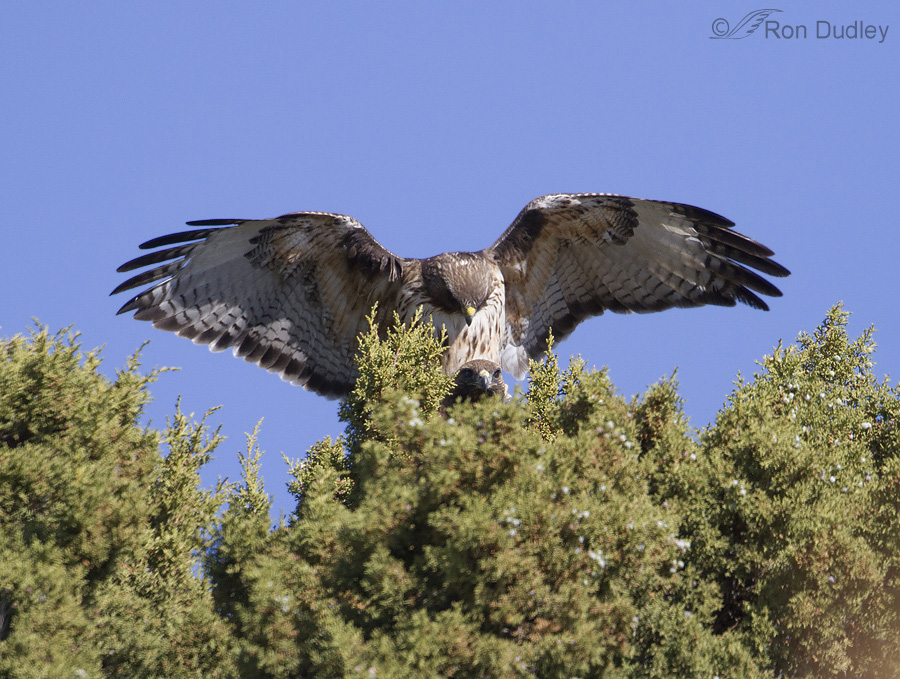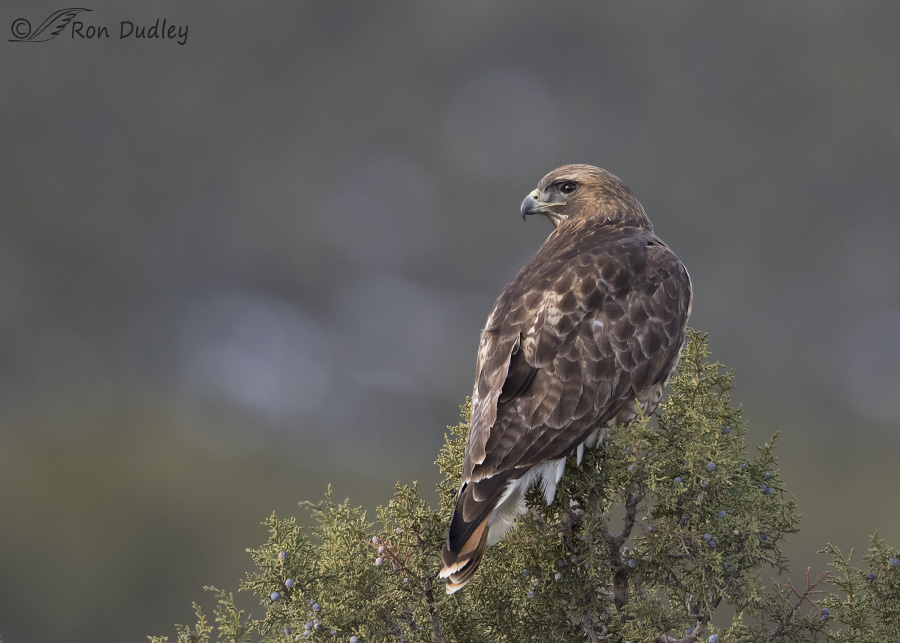I’ve been watching a Red-tailed Hawk nest in remote Tooele County for about five years now. In the spring and early summer I watch it through my lens from afar just to see if the adults fledge any youngsters. Most years they do but success is far from guaranteed.

1/2000, f/6.3, ISO 500, Canon 7D Mark II, Canon EF 500mm f/4L IS II USM + 1.4 tc, not baited, set up or called in
Just over two years ago (3/25/14) I photographed the adults as they mated in a juniper fairly near the nest. It’s fun and interesting to watch the birds from mating through incubation of the eggs, care and feeding of the young and eventual fledging but successful nesting is a long process fraught with pitfalls and one never knows the outcome.

1/400, f/5.6, ISO 800, Canon 7D Mark II, Canon EF 500mm f/4L IS II USM + 1.4 tc, not baited, set up or called in
Two days ago I found both adult hawks near the nest (one was perched in the nest tree) so I believe that this year’s nesting process has begun. As usual the birds and the nest were too far away for good photographs (I never get out of my pickup or leave the road) but one of them did land in a nearby juniper for a few moments so I was able to get a couple of decent shots in good light.
Almost certainly this bird is one of the mated pair I’ve been following at the nest over the years and I can’t tell you how happy I am to have them back. I look forward to watching them on and near the nest as the long, labor intensive process of raising youngsters proceeds. During that time the bare tree will grow leaves, the parents will spend countless hours on the nest in all kinds of weather (the female does most, though not all of the incubation) and the chicks will hatch and require almost constant feeding as they grow quickly and eventually fledge.
At least in theory. Lots of things can (and sometimes do) go wrong during the extended process.
I wish them luck.
Ron


Fantastic shots Ron!
Charlotte
Thank you, Charlotte.
Like everyone else who visits you, I too wish them luck.
And look forward to revelling in their story as it unfolds over the year.
I hope I can tell that story, EC. We’ll see how it goes…
The colors and contours of the Red-tailed hawk are so similar to that of the Golden Eagle, just much smaller, it’s easy to see why they’ve been called by some Lakota, ” little brother of the eagle”…This bird is a good example. To me, it really looks like the eagle’s (Golden’s))liitle brother…just laking in size and golden mantle…
I know what you mean, Patty. Red-tails also have an eagle-like attitude in my experience.
Patty would it surprise you to know that we falconers think they’re little eagles, too? Like Ron said, their attitude is very eagle like and they’re wonderful (you KNEW I’d say that last part, didn’t you?) LOL!
I did not know that about falconers…interesting…I love both of them …goldens and ted-tailed…
Patty if there were anywhere NEAR enough of me left to fly a golden…but there just isn’t. I’d really have to move west, too to give them enough sky. Working on that part because even Mariah (female redtail), Jack (male Baywinged hawk–AKA Harris’ hawk) and Skye (female Kestrel) need more Sky to fly properly! But a golden…sigh. I held a small male golden from John Karger’s Last Chance Forever in San Antonio, Texas. That bird’s foot DWARFED my fist, covering it completely. And he was a small male. It was glorious, but I thought it possible he could have carried me away I remain in awe. Sigh…
I remain in awe. Sigh…
I particularly like that over the shoulder shot…love all the contour curves of that bird’s outline….
Enjoy your posts as usual!
Thanks, Linda.
I love that you take us along on this journey.
I enjoy having you along for the ride, Arwen.
Your photos were timed wonderfully for me after yesterday’s arrival of a young Red tail. It was most likely hit by a car along a highway. It is nice to see healthy beautiful birds in the wild. It gives me a positive feeling.
I hope your bird recovers, April.
Love watching the red tail hawks in our neighborhood. These are beautiful shots.
Thank you, Carol.
Great wonderful shots Ron!
I got a half way decent shot of a Red-tail sitting on one of our Bluebird boxes, but had to crop the heck out of it. Used my 100-400 with extender about 100 feet away.
I would appreciate any insight you might have concerning the 500mm prime lens you have considering the issues you had to deal with.
Dick, so far so good with the repaired lens. When I have good light the images are very, very sharp and I’m getting great detail. This image for example was cropped to exactly 50% of the original and I have oodles of detail and the bird is sharp throughout.
In low light or low contrast situations I sometimes get images that aren’t this sharp but that may be just the nature of the beast.
Thanks Ron,
Dick
Glorious shots, as usual, and oh how I love redtails!! But you knew that!
And I agree completely. That’s exactly why I’ve spent countless hours moderating the chat and operating the cam on the Cornell Redtail Hawk nest cam project over the last four years (and getting ready to start it up again this year). I’m absolutely fascinated with their parenting process from mating and nest-building through the Zen of Incubation, hatching, child rearing to fledge and beyond. Big Red and Ezra are mature, experienced parents, so thus far, their fledge success is 100% in the last four years. It gets iffy after that, but they’re excellent parents.
Also interesting is that keeping a close eye on them has proven many of the book-learning facts to be wrong. Despite that redtails are too big and cumbersome to catch small birds, Ezra brings a wide variety of small birds to the nest for baby food, proving that redtails can and do catch anything that fits in that foot, whether its furred, feathered or scaled.
Redtails have my heart–utterly, completely and profoundly. Despite that people call them common, there’s just nothing common about them and we’re blessed to have them here. BTW, Mariah says the words to use are abundant and/or plentiful (along with spectacular).
Laura, I know a bird photographer who once said that he doesn’t photograph red-tails because they’re so “common” in his area. Go figure…
Well Ron, some folks are just inexplicably and persistently dim…what’re you gonna do?
I agree. Red-tailed hawks are marvelous creatures. One of the best kept secrets of the avian world.
I was present a couple months ago, when a small juvenile, probably a male, knocked a mobbing kestrel out of the sky and had it for lunch. This was during very windy conditions where you would think a small, agile falcon like a kestrel would be untouchable. Not bad for a lowly buzzard!
Wow, that would be something to see, Mark!
I felt bad for the kestrel, but he was asking for it. Truthfully, if I had been a little closer to the action, I would have tried to save the kestrel since their numbers are in serious decline.
It is fun to watch it all. We generally have a pair of Great Horned Owls nesting in the yare and it’s an annual source of entertainment. Great shots, Ron.
I envy you your GHO’s, Judy. My best chance with them is usually in Montana.
I might not comment on every blog you post, but I sure do read/look at them all and am always impressed by the photos and the associated observations. Thank you for sharing what it is you see Zaph
Zaph
No need to comment on every post, Zaph, but I do enjoy knowing you’re “out there”. Thank you.
Great images Ron! It is fun to watch the whole process unfold. I have done this with Ospreys and bald Eagles and it is a treat. Keep up the good posts- enjoy!
Thank you, Bob – for the kind words about the images and for the encouragement.